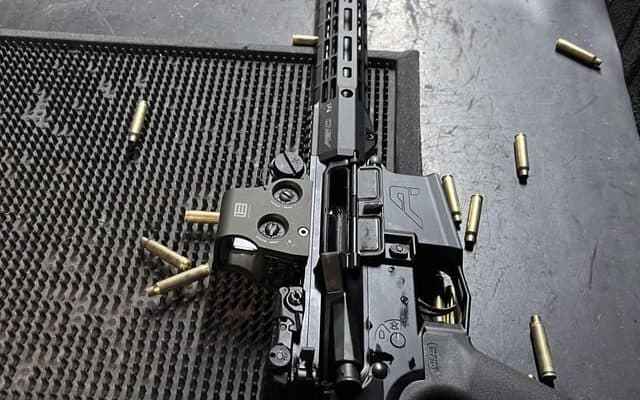Clean your AR-15 after every use and at least once a month if not used. Regular maintenance ensures optimal performance.
AR-15 rifles require regular cleaning to maintain reliability and longevity. Frequent use leads to carbon buildup and debris, which can affect performance. By cleaning your AR-15 after each session at the range, you prevent malfunctions and extend the life of your firearm.
Even if the rifle sits idle, monthly cleanings are essential to remove dust and moisture that can cause corrosion. Proper maintenance also includes lubricating the moving parts to ensure smooth operation. By following a consistent cleaning routine, you ensure your AR-15 remains in peak condition, ready for use whenever needed.
Importance Of Cleaning Your Ar-15
Cleaning your AR-15 is essential for its performance and longevity. A clean rifle ensures it works well every time you need it. Neglecting to clean your AR-15 can lead to issues that affect its reliability and lifespan.
Ensuring Reliability
An AR-15 must be reliable for every shot. Dirt and grime can cause malfunctions. This can make it unsafe to use. Regular cleaning removes harmful debris. It keeps the rifle functioning smoothly. A reliable AR-15 is crucial for both target practice and home defense.
Extending Lifespan
Cleaning your AR-15 extends its lifespan. Metal parts can rust without proper care. Regular cleaning prevents rust and corrosion. This keeps your rifle in good condition for years. Regular maintenance saves money on repairs and replacements.
Basic Cleaning Frequency
Keeping your AR-15 clean ensures it works well. Cleaning removes dirt and debris. This helps the rifle function properly. Below are guidelines on how often you should clean your AR-15.
After Each Use
Clean your AR-15 after every use. Even if you fire a few rounds, clean it. This keeps the rifle in good shape. Follow these steps:
- Field strip the rifle.
- Clean the barrel with a bore brush.
- Wipe down the bolt carrier group.
- Lubricate moving parts.
- Reassemble the rifle.
Regular cleaning reduces wear and tear. It also prevents malfunctions. Make it a habit to clean your AR-15 after each use.
Monthly Maintenance
Even if you don’t use your AR-15, clean it monthly. This prevents dust and rust buildup. Monthly maintenance involves a few steps:
- Inspect the rifle for any signs of wear.
- Wipe down all parts with a clean cloth.
- Check for proper lubrication.
- Ensure no parts are loose.
Use a light coat of oil to prevent rust. Store the rifle in a dry place. Monthly cleaning keeps the rifle ready for use.
For a quick reference, see the table below:
| Cleaning Task | Frequency |
|---|---|
| Field Strip & Clean | After Each Use |
| Barrel Cleaning | After Each Use |
| Lubrication | After Each Use |
| Monthly Check | Once a Month |
Keeping up with these cleaning tasks ensures your AR-15 remains in top condition. A well-maintained rifle is safe and reliable.
Factors Influencing Cleaning Schedule
Cleaning your AR-15 regularly ensures its optimal performance and longevity. The frequency of cleaning depends on several factors, including usage intensity and environmental conditions. By understanding these factors, you can establish an effective cleaning routine for your firearm.
Usage Intensity
How often you use your AR-15 greatly affects the cleaning schedule. Frequent use means more residue and fouling build-up. Here are some guidelines based on usage intensity:
- Heavy Use: Clean your AR-15 after every session at the range. This includes competitive shooters and those who train frequently.
- Moderate Use: If you shoot once or twice a month, clean it after every 500 rounds.
- Light Use: For occasional use, cleaning every 1000 rounds should suffice.
Environmental Conditions
The environment in which you use your AR-15 also plays a crucial role. Different conditions can accelerate the need for cleaning:
| Condition | Cleaning Frequency |
|---|---|
| Dusty or Sandy | Clean after each use to prevent debris build-up. |
| Humid | Frequent cleaning to avoid rust and corrosion. |
| Wet or Muddy | Clean immediately to remove moisture and mud. |
By paying attention to these factors, you can maintain your AR-15 in top condition. Proper cleaning ensures your firearm remains reliable and safe.
Signs Your Ar-15 Needs Cleaning
Knowing when to clean your AR-15 is crucial for its performance. Proper maintenance ensures reliability and longevity. Here are the key signs your AR-15 needs cleaning.
Performance Issues
Your AR-15 might show performance issues if it needs cleaning. Misfires and failure to feed are common signs. You may also notice a decrease in accuracy. These symptoms indicate that dirt and residue are affecting the firearm’s mechanisms.
Another sign is a sluggish bolt carrier group. If it moves slowly, it’s time for a thorough cleaning. Stovepipes and double feeds are other indicators. Regular cleaning can prevent these issues and ensure smooth operation.
Visible Dirt And Residue
Visible dirt and residue are clear signs your AR-15 needs cleaning. Check the exterior and the barrel for grime. If you see carbon buildup, it’s time to clean. The bolt carrier group and chamber are also prone to residue.
Use a flashlight to inspect hard-to-see areas. Pay attention to the gas tube and gas key. These components can collect dirt over time. Cleaning these areas will improve your firearm’s reliability.
Essential Cleaning Tools
Keeping your AR-15 in top shape requires the right tools. These tools ensure your rifle functions smoothly and lasts longer. Let’s explore the essential cleaning tools you need.
Cleaning Kits
A cleaning kit is a must-have for any AR-15 owner. These kits usually contain:
- Bore brushes: Clean the inside of the barrel.
- Cleaning rods: Help push patches through the barrel.
- Patch holders: Hold cleaning patches in place.
- Chamber brushes: Clean the chamber area.
Some kits also include specialized tools like dental picks. These are useful for hard-to-reach areas.
Lubricants And Solvents
Using the right lubricants and solvents keeps your AR-15 in perfect condition. Here are some common types:
| Type | Use |
|---|---|
| CLP (Cleaner, Lubricant, Protectant) | All-in-one solution for cleaning and lubrication. |
| Bore Cleaner | Removes carbon and copper fouling from the barrel. |
| Gun Oil | Lubricates moving parts to reduce wear and tear. |
Always use high-quality products to ensure the best results for your rifle.
Step-by-step Cleaning Process
Keeping your AR-15 clean is crucial for its performance. A step-by-step cleaning process ensures your firearm stays in top shape. Follow this guide to clean your AR-15 effectively.
Disassembly
First, ensure your AR-15 is unloaded. Remove the magazine and check the chamber.
- Separate the upper and lower receivers. Push out the rear takedown pin and pivot the upper receiver.
- Remove the bolt carrier group and charging handle from the upper receiver.
- Disassemble the bolt carrier group by removing the firing pin, cam pin, and bolt.
Cleaning The Barrel
Cleaning the barrel is essential for accuracy and performance. Follow these steps for a thorough clean:
- Attach a bore brush to your cleaning rod.
- Apply bore cleaner to the brush and run it through the barrel several times.
- Use a clean patch on the cleaning rod to wipe out the residue.
- Repeat until the patches come out clean.
Tip: Always clean from the chamber end to the muzzle end to protect the barrel’s rifling.
| Step | Description |
|---|---|
| 1 | Ensure firearm is unloaded |
| 2 | Separate upper and lower receivers |
| 3 | Remove bolt carrier group and charging handle |
| 4 | Disassemble bolt carrier group |
| 5 | Clean barrel with bore brush and cleaner |
| 6 | Wipe out residue with clean patches |
Follow these steps to ensure a clean and well-maintained AR-15. Regular cleaning keeps your firearm reliable and accurate.
Common Cleaning Mistakes
Cleaning your AR-15 is crucial for its performance and longevity. Many enthusiasts make common mistakes during the cleaning process. These mistakes can affect the rifle’s functionality and durability. Here, we discuss two of the most common errors: Over-Lubrication and Skipping Components.
Over-lubrication
Many people think more lubrication is always better. This is not true. Over-lubrication can attract dirt and grime. This can affect the rifle’s performance.
Stick to the recommended amount of lubricant. Use a light coating on moving parts. This will keep your AR-15 running smoothly.
Excess oil can seep into unwanted areas. This can cause malfunctions. Always wipe off any extra oil after application.
Skipping Components
Some users clean only the barrel and exterior. They skip important components like the bolt carrier group and gas tube. This is a big mistake.
- Bolt Car

Credit: thunderguns.com
Expert Maintenance Tips
Maintaining your AR-15 is crucial for its longevity and performance. Regular cleaning and proper care will ensure your firearm operates smoothly. Follow these expert tips to keep your AR-15 in top condition.
Routine Inspections
Perform routine inspections to spot potential issues early. Check the barrel, chamber, and bolt carrier group. Look for signs of wear, rust, or dirt. Use a flashlight to inspect hard-to-see areas. Clean and lubricate these parts as needed.
| Part | Inspection Frequency |
|---|---|
| Barrel | After every shooting session |
| Chamber | After every shooting session |
| Bolt Carrier Group | After every shooting session |
- Use a cleaning kit for thorough cleaning.
- Inspect the gas system for carbon build-up.
- Check the buffer tube for debris.
Proper Storage
Proper storage is vital for your AR-15’s longevity. Store your firearm in a cool, dry place. Use a gun safe or cabinet to protect it from moisture and dust. Consider using a dehumidifier in your storage area.
- Disassemble the AR-15 for storage if possible.
- Wipe down all metal parts with a lightly oiled cloth.
- Store the firearm in a case or safe.
For long-term storage, apply a thin layer of rust-preventative oil to all metal surfaces. This will help prevent corrosion. Always keep your AR-15 unloaded when not in use.
Frequently Asked Questions
How Often Should I Clean My Ar-15?
You should clean your AR-15 after every use. Regular maintenance ensures reliability and longevity. Clean the barrel, chamber, and bolt carrier group thoroughly.
What Happens If I Don’t Clean My Ar-15?
Neglecting to clean your AR-15 can lead to malfunctions. Dirt and carbon buildup can cause jams and reduce accuracy.
How Do I Clean The Ar-15 Barrel?
Use a bore brush and solvent to clean the barrel. Run the brush through the barrel multiple times, then dry with patches.
Can I Use Any Solvent To Clean My Ar-15?
Use a solvent specifically designed for firearms. It effectively removes carbon and fouling without damaging the rifle’s components.
Conclusion
Regular cleaning of your AR-15 ensures optimal performance and longevity. Follow a routine based on usage frequency. Light cleaning after every use and deep cleaning after 500-1000 rounds is ideal. Consistent maintenance not only enhances reliability but also keeps your firearm in top condition.
Take care of your AR-15, and it will take care of you.
Related Post:



